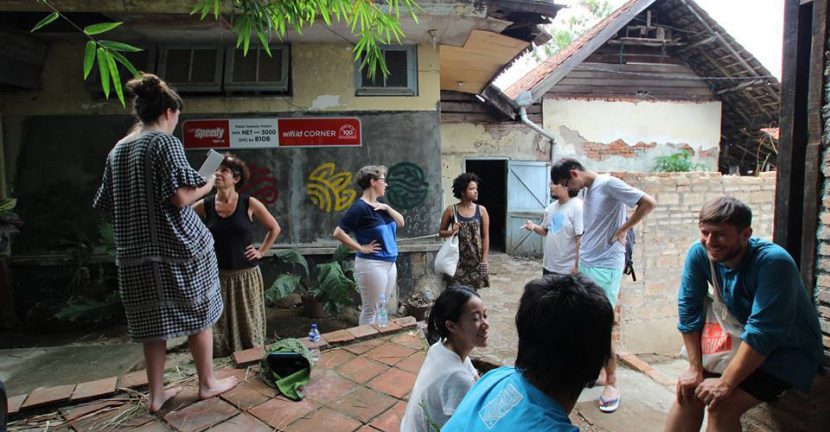In which context are you working as an art educator?
Ruth Noack: At the moment, I am teaching artists in the framework of an M.A. at the Dutch Art Institute, but I’ve worked in different art education contexts throughout my adult life.
Who are you working with?
RN: With colleagues from different fields and all wakes of life. With artists. With my students.
How would you describe your understanding of art education?
RN: Art education should be a process of negotiation between the different parties and art objects involved. It is only education if all human actors and institutions involved do the learning.
How would you describe the relation between education and art?
RN: Ideally, they inspire each other.
Why mediate (contemporary) art?
RN: There is a difference between mediation and education. I am more interested in the latter. Most contemporary art is part of specialised discourses. It cannot be assumed that these discourses are known to potential viewers. At the very least, educators/curators/institutions should enable viewers to understand that this is the case, while also making clear that education or specialization might just be one of many possible routes to understanding a work of art.
Please describe the relation between working as a curator and working as an art educator from your point of view.
RN: Both have discrete subject formations, which puts them into different relationships to power. The stereotype is that a curator has more power and is better paid than an educator, and certainly, this is still the rhetoric and practice of many museums, but I doubt that the stereotype would hold up in empirical terms, given the educational turn.
How important is art education and mediation for a museum / an institution?
RN: Ideally, institutions will understand the potential of art education: More than mediating the art or the institution, art education can help institutions to understand themselves as “permanently in negotiation”, evolving.
Which institutions provide the opportunity to discuss our personal experiences with art?
RN: I find institutions far less homogeneous than often described. The spaces that provide opportunity to discuss anything well are always specific: they are organisms that might involve particular people, singular art practices, distinct architecture, noteworthy institutional histories or practices, and an active audience.
To what extent does teaching/mediating art provide the opportunity to concrete actions for the audience?
RN: This depends on how self-reflective and institutionally secure the educators are – a prerequisite is that they are allowed to experiment with different situations. Sometimes, all that is needed is to let people know that the institution welcomes their agency. Sometimes, agency is only to be had by working through conflicts.
In your personal opinion, what are the criteria for successfully mediating art? In your point of view, what is especially difficult about it?
RN: I find the call for criteria in educational processes problematic, because it more often than not belongs to a general tendency to measure the success or failure of an educational practice according to economised or otherwise governmentally over-determined discourses. The only true measure of education is freedom, i.e. the freedom to exercise one’s mind and one’s rights, the freedom to experience oneself as being in the world shared by many, etc.
Have you developed a special method or innovative strategy you’re working with?
RN: Improvisation based on equal measures of experience, knowledge and inspiration.
What are you working on at the moment?
RN: I am intent on making an art institution in a public school.
Which books, projects etc. were/are important for your work – and why?
RN: I am mostly inspired by people. Right now, some of these are Gabi Ncobo, Luis Jacob, Antke Engel, Tina Gverović, May Adadol Inganwanji, Marcelo Recende, Gabrielle Schleijppen, John Barker, Anna Daučíková, Uli Sigg, Grace Samboh, Hafiz Rancajale, Otty Widasari, Scott Miller Berry, Mary Ellen Carroll, Ines Doujak, Gangart, Leo Baumfeld, Manuela Ammer, Silke Ballath, Anja Scheffer…
Is there a special question you would like to ask an art educator?
RN: Why do you care about art?
How would you imagine the future of art education?
RN: Actively anti-professional. Based on a self-reflexive, desiring, political ethos of education.
Ruth Noack trained as a visual artist and art historian, she has worked as author, art critic, university lecturer and exhibition maker since the 1990s. Noack was curator of documenta 12 (2007). Exhibitions include Scenes of a Theory (1995), Things We Don’t Understand (2000), The Government (2005) and Not Dressed for Conquering – Ines Doujak’s Loomshuttles/Warpaths (2012). Notes on Crisis, Currency and Consumption (2015) was the first of a series of ten essay-exhibitions on issues of contemporary life. Next will be Sleeping with a Vengeance − Dreaming of a Life and Fragments and Compounds. Head of the Curating Contemporary Art Program, Royal College of Art, London (2012-13), she acted as Research Leader for the EU-project MeLa – European Museums in an age of migrations. Noack was Šaloun professor at the Academy of Fine Arts, Prague (2013-14) and lead the Gwangju Biennale International Curator Course in 2014. Since 2015, she is responsible for one of the DAI Roaming Academy trajectories. Next to articles and scholarly essays published internationally, she has written Sanja Ivekovic,: Triangle for Afterall Books and Agency, Ambivalence, Analysis. Approaching the Museum with Migration in Mind (both 2013).
Published Juli 9, 2016.
Interview: Gila Kolb
Image: Ruth Noack
